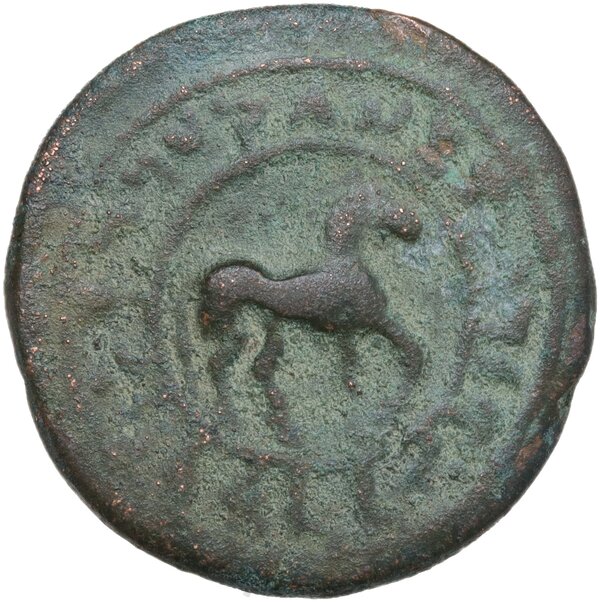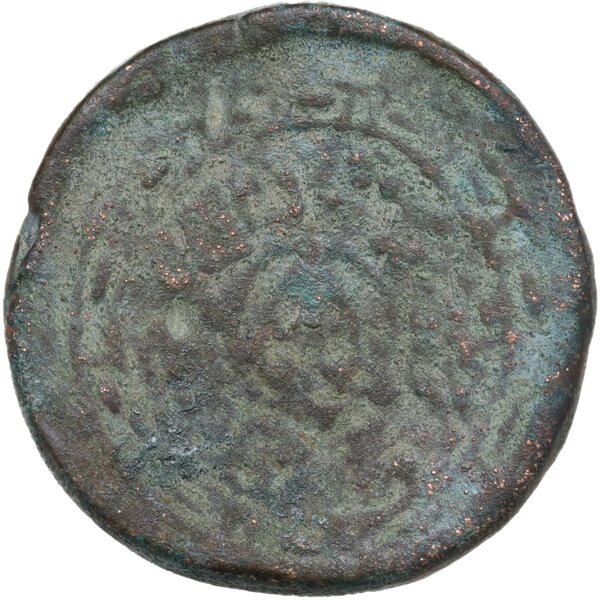An extremely rare and historically mininguful coin of the Silk Road


Lotto 296:
Khotan. AE Tetradrachm / 24 zhou Sino-Kharosti bilingual issue, Yutian mint. Obv. Horse and kharosthi inscription 'Maharajasa rajatirajasa Yidi rajasa Gurgamoyasa' (of the Great King, King of the Kings, the Yutian King, Gurgamoa). Rev. Tamgha of Gurga kings of Yutian, Chinese inscription 重廿四銖銅錢 (copper coin weighing 24 zhu). Joe CRIBB, « The Sino-Kharosthi Coins of Khotan », I, NC, vol. 144, 1984, 128-152; II, NC, vol. 145, 1985, 136-149, type 7. 16.92 g. 29.00 mm. RRR. VF. The Khotan Empire, also known as the Yutian Kingdom, was a powerful state that existed in the Tarim Basin of Central Asia from the 2nd century BCE to the 8th century CE. This region was strategically located along the ancient Silk Road trade route, which connected China to the Mediterranean. As a result, the Khotan Empire played a significant role in facilitating the exchange of goods, ideas, and cultures between East and West.
The Silk Road trade was a vital source of economic, cultural, and technological exchange for the Khotan Empire. Khotan was renowned for its production of high-quality silk, which was highly sought after by merchants and aristocrats across the ancient world. In exchange for silk, the Khotan Empire received a wide range of luxury goods, such as spices, precious metals, gemstones, and textiles. The Silk Road trade also brought new religions, languages, and ideas to the Khotan Empire, including Buddhism, Manichaeism, and Nestorian Christianity.
The Khotan Empire was also strategically located at the crossroads of several other major trade routes, such as the Northern Route and the Southern Route of the Silk Road. This gave the Khotan Empire a strategic advantage in controlling and regulating the flow of goods and people across Central Asia. The Khotan Empire's location also made it a hub for cultural exchange and the diffusion of ideas between different regions and civilizations.
Despite its strategic importance, the Khotan Empire was not immune to the political and economic challenges that affected other empires along the Silk Road. In the 7th and 8th centuries CE, the rise of the Tang Dynasty in China and the expansion of the Arab Empire disrupted the Silk Road trade and weakened the Khotan Empire's economic and political power. The Khotan Empire eventually fell to the Arab Empire in the mid-8th century CE, marking the end of its centuries-long reign as a major power along the Silk Road.
In conclusion, the Khotan Empire was a significant player in the Silk Road trade and a crucial link between East and West. Its strategic location, cultural richness, and economic power made it an important hub for the exchange of goods, ideas, and technologies. Despite its eventual decline, the legacy of the Khotan Empire's contributions to the Silk Road trade lives on today, as the region continues to be a vital center for trade, commerce, and cultural exchange.
The Sino-Kharosthi 24 zhu coin is a remarkable testament to the cultural and linguistic exchange that took place along the Silk Road trade routes. This rare and valuable coin features inscriptions in two distinct languages: Chinese and Kharosthi. The Chinese inscription appears on one side of the coin, while the Kharosthi inscription is on the other, making this coin a true bilingual rarity.
The Chinese inscription on the coin indicates that it was minted during the Han dynasty, which lasted from 206 BCE to 220 CE. The coin's denomination is 24 zhu, which was equivalent to 1/10 of a tael of silver. The Kharosthi inscription, on the other hand, suggests that the coin was intended for use in regions of Central Asia where the Kharosthi script was commonly used.
The Silk Road trade was a vital source of economic, cultural, and technological exchange for the Khotan Empire. Khotan was renowned for its production of high-quality silk, which was highly sought after by merchants and aristocrats across the ancient world. In exchange for silk, the Khotan Empire received a wide range of luxury goods, such as spices, precious metals, gemstones, and textiles. The Silk Road trade also brought new religions, languages, and ideas to the Khotan Empire, including Buddhism, Manichaeism, and Nestorian Christianity.
The Khotan Empire was also strategically located at the crossroads of several other major trade routes, such as the Northern Route and the Southern Route of the Silk Road. This gave the Khotan Empire a strategic advantage in controlling and regulating the flow of goods and people across Central Asia. The Khotan Empire's location also made it a hub for cultural exchange and the diffusion of ideas between different regions and civilizations.
Despite its strategic importance, the Khotan Empire was not immune to the political and economic challenges that affected other empires along the Silk Road. In the 7th and 8th centuries CE, the rise of the Tang Dynasty in China and the expansion of the Arab Empire disrupted the Silk Road trade and weakened the Khotan Empire's economic and political power. The Khotan Empire eventually fell to the Arab Empire in the mid-8th century CE, marking the end of its centuries-long reign as a major power along the Silk Road.
In conclusion, the Khotan Empire was a significant player in the Silk Road trade and a crucial link between East and West. Its strategic location, cultural richness, and economic power made it an important hub for the exchange of goods, ideas, and technologies. Despite its eventual decline, the legacy of the Khotan Empire's contributions to the Silk Road trade lives on today, as the region continues to be a vital center for trade, commerce, and cultural exchange.
The Sino-Kharosthi 24 zhu coin is a remarkable testament to the cultural and linguistic exchange that took place along the Silk Road trade routes. This rare and valuable coin features inscriptions in two distinct languages: Chinese and Kharosthi. The Chinese inscription appears on one side of the coin, while the Kharosthi inscription is on the other, making this coin a true bilingual rarity.
The Chinese inscription on the coin indicates that it was minted during the Han dynasty, which lasted from 206 BCE to 220 CE. The coin's denomination is 24 zhu, which was equivalent to 1/10 of a tael of silver. The Kharosthi inscription, on the other hand, suggests that the coin was intended for use in regions of Central Asia where the Kharosthi script was commonly used.
Base d'asta € 500
Prezzo attuale € 1050
Offerte: 12
Lotto non in vendita
Prezzo attuale € 1050
Offerte: 12
Lotto non in vendita





